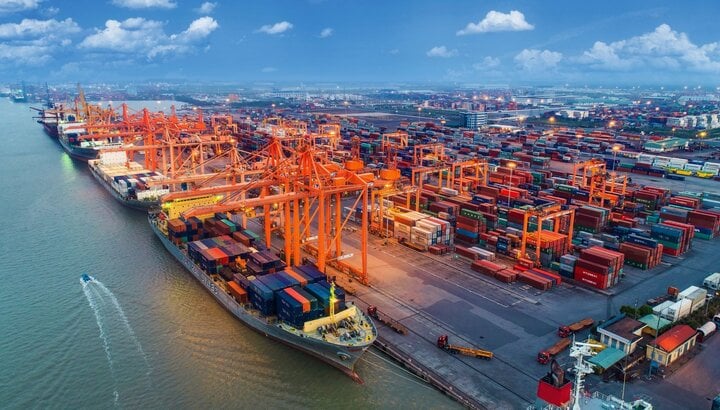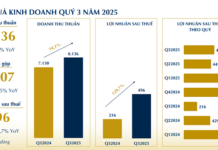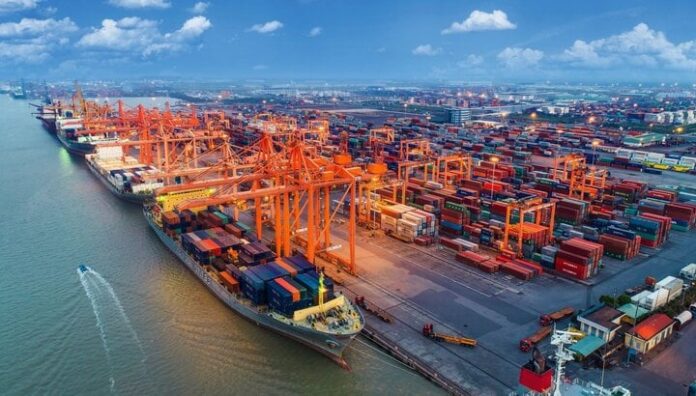The Vietnam Maritime Administration reported to VTC News that maritime freight rates have been continuously decreasing in recent days. On average, maritime freight rates are dropping by 3-4% weekly and are expected to continue this downward trend, currently 4% lower than last week.
Meanwhile, the import and export cargo volume through seaports has witnessed a remarkable surge, reaching a five-year record high.
Specifically, the cargo volume through Vietnamese seaports in the first seven months of 2024 is estimated at 501.117 million tons, a 16% increase compared to the same period in 2023. Container cargo is estimated at 16.902 million TEUs, a 21% year-over-year increase.
“This is the highest growth rate in the past five years and three times the average growth rate of 5.5% during this period. Notably, the Cai Mep – Thi Vai deep-water port area handled 2.8 million TEUs of import and export containers, a 41% increase compared to 2023. The Lach Huyen port area achieved 875,000 TEUs, an 87% increase from 2023,” the Vietnam Maritime Administration stated.

Maritime freight rates are on a downward trend. (Illustrative image)
Previously, commenting on the sharp increase in maritime freight rates, which caused difficulties for domestic enterprises, the Vietnam Maritime Administration explained that freight rates fluctuate according to market supply and demand. Due to its highly open economy, Vietnam is an integral part of the global supply chain, and freight rates for cargo transportation through its ports are no exception to this global trend.
Currently, most Vietnamese importers and exporters do not directly pay freight charges. However, the surge in freight rates compels them to adjust their product prices, impacting their competitiveness in the market.
The Vietnam Maritime Administration informed that the ratio of import and export cargo directly booked by Vietnamese shippers is low, mainly on a CIF-FOB basis (approximately over 80%). Therefore, freight contracts and rates are usually handled by foreign partners. Specifically, for the route to the Americas, the booking ratio in Vietnam is only about 10%.
“Regarding Vietnamese shippers who sign long-term transport contracts with shipping lines, they are often large companies with stable import and export cargo volumes. These long-term transport contracts are not affected by market price fluctuations, and freight rates remain stable throughout the contract’s validity period.
On the other hand, small and medium-sized shippers with unstable cargo sources will be directly affected by freight rate fluctuations.
Additionally, some shippers do not sign contracts directly with shipping lines but instead go through forwarders who provide additional services beyond transportation. Consequently, these small and medium-sized shippers have to bear the extra cost of the freight rate differential,” the Vietnam Maritime Administration assessed.
Therefore, the Vietnam Maritime Administration recommends that Vietnamese enterprises consider long-term contract signing with international partners to mitigate the impact of freight rate fluctuations. Industry associations should guide the production activities of their member companies and consolidate cargo sources from enterprises to sign long-term and stable transport contracts with shipping lines, thereby reducing risks associated with price volatility.
Recently, shipping rates on key routes have soared. There was a time when the cost of a container to Europe was around $4,000-5,000, more than double what it was at the end of last year. Shipping rates to the US also increased similarly, reaching $6,000-7,000/container. Rates to nearby regions such as China, Japan, South Korea, and Southeast Asia rose by $1,000-2,000/container.
By the end of July, rates had dropped on all routes, with the most significant decrease on the Asia-US West Coast route, falling by about 20-30%. Other shipping routes also saw decreases of around 15-25%.
The Vietnam Maritime Administration forecasts that this cooling trend will persist.





































